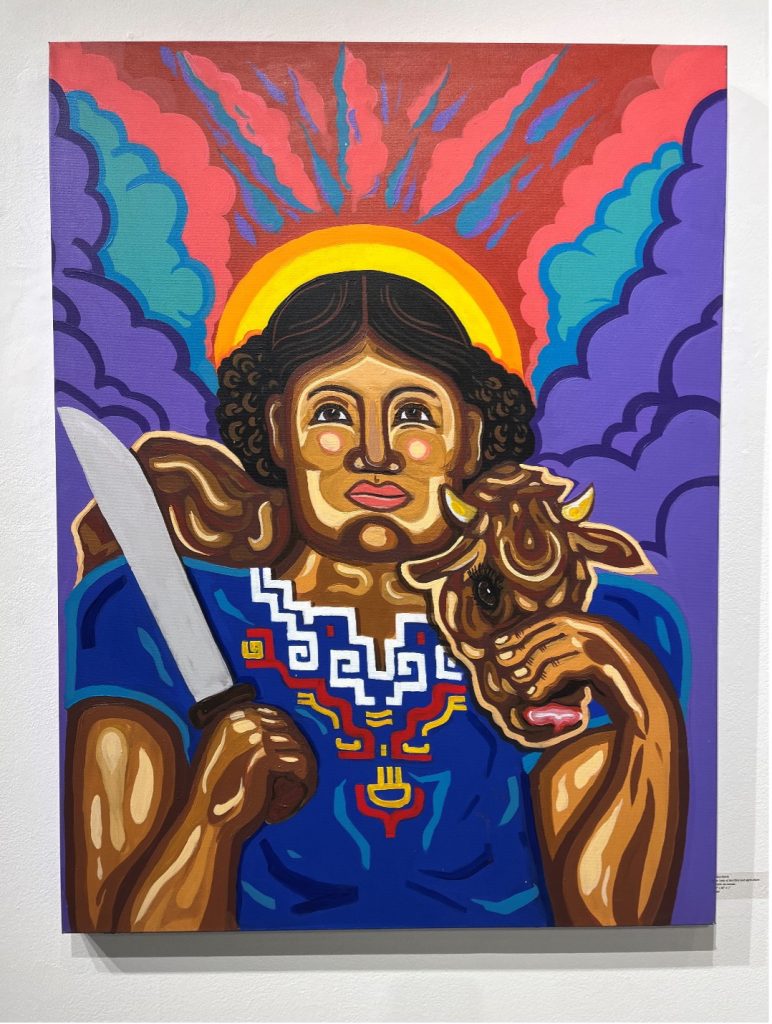by Hayley Acevedo
In the Dedo Maranville Fine Arts Gallery, Chico Sierra’s exhibition The Good Sun brings together expressionism, cultural symbolism, and personal experience. As a Mexican-American artist, Sierra draws inspiration from his Indigenous heritage, combining it with expressionist techniques to captivate and immerse viewers. His collection of paintings feels alive and vibrant, encouraging deeper engagement with themes of identity, culture, and spirituality.
One of the most striking aspects of Sierra’s work is his expressionist style. I had the opportunity to watch him paint a mural in the gallery, and what stood out was how organic his process is. He doesn’t appear to begin with a strict plan or sketch; instead, he paints intuitively, responding to the moment. As he adds color, lines, and shapes, the paintings seem to come to life on their own. Sierra explained that the bigger picture begins to emerge as he works, which reflects expressionism’s emphasis on emotion over predetermined outcomes.
Looking at the formal qualities of Sierra’s paintings, his use of color and form closely resembles elements of Aztec and Mesoamerican art. Rather than blending colors, he emphasizes bold hues and defined, blocky lines. This approach gives his work a graphic, Aztec-inspired aesthetic. Pieces like The Good Sun and Our Lady of Sacrifice and Agriculture are excellent examples of how Sierra uses vibrant color to depict intricate detail. In Our Lady of Sacrifice and Agriculture, the minimal shading on the woman’s face lends her a jovial expression, while the bold background colors enhance—rather than distract from—her figure. In The Good Sun, Sierra uses strong lines to portray a man ripping open his chest, revealing a flat sun in place of his head. His use of flat color to highlight the central figure demonstrates his command of the medium.

Sierra’s work also explores broader themes of race, identity, and culture. As a Hispanic artist, he resists the conventional labels often applied to Chicano or Mexican-American identities. Instead, he embraces his Indigenous Mexican roots. This connection is evident in his frequent use of symbols such as cacti, snakes, and bulls, which carry deep cultural significance. These elements form part of a larger narrative about the strength and resilience of Indigenous communities. In works like Sisters of Common Threads and Our Lady of Sacrifice and Agriculture, these symbols help express Sierra’s personal connection to his ancestral traditions.

What particularly drew me to the exhibition was Sierra’s portrayal of women. Though he is a male artist, he frequently centers women of color in his work, doing so in a way that avoids objectification. His female figures are rendered with power, dignity, and emotional depth. In Sisters of Common Threads, for instance, the women exude a spiritual or maternal presence rather than appearing passive. Religious imagery—particularly the Virgin Mary—is also a clear influence. In The Revolution of Inheritance, a mother is depicted nude with a halo above her head, holding a baby. Beneath them lies a dead snake, a traditional symbol of evil in Christianity. The imagery suggests that the mother has killed the snake to protect her child. This iconography reflects Sierra’s Mexican heritage and the influence of Catholic colonization. However, despite using religious symbols, Sierra himself is not religious. His focus seems to be on using religious imagery to explore themes such as strength, female empowerment, and divinity, rather than promoting Christianity.